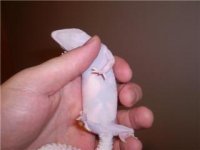greenknight exotics
New member
I have found this site through meeting others, and am looking for any advise on how to help my raptor female. I could care less about the eggs,...I'm only worried about her.
I've given her soaks in tepid baths that come up to her upper thighs, only for about 2 or so minutes, I've got her moist coco husk hide near the heat strip, so she's sitting in the mid to high 80's, and she's now dug a bit and is looking ready to lay,...the only problem is that she's been doing this for days! As you can see her tail is super thin, it will be her 3rd or 4th clutch(she's housed with another female), so I attributed it to her laying,....but she's obviously bound now.
Any obscure pointers out there?? Like I said, I don't care about the eggs,..I just really don't want her to die.
Thanks,
Dave
I've given her soaks in tepid baths that come up to her upper thighs, only for about 2 or so minutes, I've got her moist coco husk hide near the heat strip, so she's sitting in the mid to high 80's, and she's now dug a bit and is looking ready to lay,...the only problem is that she's been doing this for days! As you can see her tail is super thin, it will be her 3rd or 4th clutch(she's housed with another female), so I attributed it to her laying,....but she's obviously bound now.
Any obscure pointers out there?? Like I said, I don't care about the eggs,..I just really don't want her to die.
Thanks,
Dave





